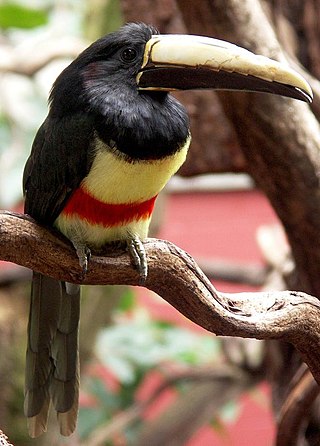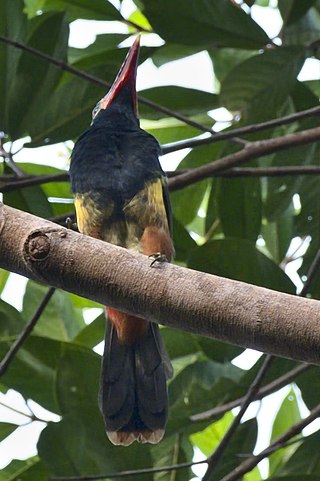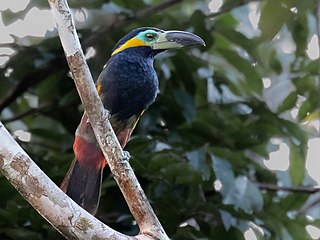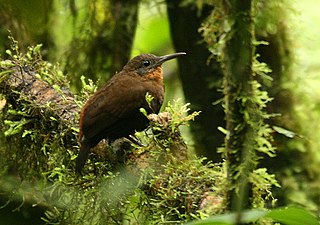
The white-throated toucan is a near-passerine bird in the family Ramphastidae found in South America throughout the Amazon Basin including the adjacent Tocantins and Araguaia River drainage. It prefers tropical humid forest, but also occurs in woodland and locally in riverine forest within cerrado.

The collared aracari or collared araçari is a near-passerine bird in the toucan family Ramphastidae. It is found from Mexico to Colombia and Venezuela.

The yellow-throated toucan is a Near Threatened species of bird in the family Ramphastidae, the toucans, toucanets, and aracaris. It is found from Honduras south into northern South America and beyond to Peru.

The red-breasted toucan or green-billed toucan is a bird in the family Ramphastidae, the toucans, toucanets, and aracaris. It is found in Argentina, Brazil, Bolivia and Paraguay.

The groove-billed toucanet is a near-passerine bird in the toucan family Ramphastidae. It is found in Colombia and Venezuela.

The black-necked aracari or black-necked araçari is a near-passerine bird in the toucan family Ramphastidae. It is found in Brazil, French Guiana, Guyana, Suriname, and Venezuela.

The ivory-billed aracari or ivory-billed araçari is a near-passerine bird in the toucan family Ramphastidae. It is found in Brazil, Colombia, Ecuador, Peru, and Venezuela.

The pale-mandibled aracari or pale-billed araçari is a near-passerine bird in the toucan family Ramphastidae. It is found in Ecuador and Peru.

The lettered aracari or lettered araçari is a near-passerine bird in the toucan family Ramphastidae. It is found in Bolivia, Brazil, Colombia, Ecuador, and Peru.

The many-banded aracari or many-banded araçari is a near-passerine bird in the toucan family Ramphastidae. It is found in Brazil, Colombia, Ecuador, Peru, and Venezuela.

The stripe-billed aracari or stripe-billed araçari is a near-passerine bird in the toucan family Ramphastidae. It is found in Colombia, Ecuador, and Panama.

The Guianan toucanet, or Guyana toucanet is a near-passerine bird in the toucan family Ramphastidae. It is found in Brazil, French Guiana, Guyana, Suriname, and Venezuela.

The tawny-tufted toucanet is a near-passerine bird in the toucan family Ramphastidae. It is found in Brazil, Colombia, Venezuela, and possible Guyana.

The golden-collared toucanet is a near-passerine bird in the toucan family Ramphastidae. It is found in Bolivia, Brazil, Colombia, Ecuador, and Peru.

The yellow-eared toucanet is a near-passerine bird in the toucan family Ramphastidae. It is found from Honduras to Ecuador.

The Chocó trogon, also known as the white-eyed trogon or blue-tailed trogon, is a species of bird in the family Trogonidae, the quetzals and trogons. It is found in Colombia and Ecuador.

The citron-throated toucan is a near-passerine bird in the family Ramphastidae, the toucans, toucanets, and aracaris. It is found in Colombia and Venezuela.

The Pacific tuftedcheek is a passerine bird in the Furnariinae subfamily of the ovenbird family Furnariidae. It is found in Colombia and Ecuador.

The white-throated toucanet or greyish-throated toucanet is a near-passerine bird in the toucan family Ramphastidae. It is found in Colombia, Ecuador, and Venezuela.

The dusky leaftosser or South American leaftosser is a bird in subfamily Sclerurinae, the leaftossers and miners, of the ovenbird family Furnariidae. It is found in Bolivia, Brazil, Colombia, Ecuador, French Giana, Guyana, Panama, Peru, Suriname, and Venezuela.
























